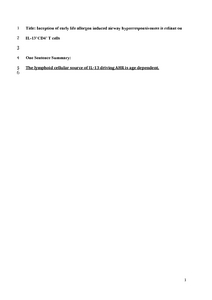Saglani, S;
Gregory, LG;
Manghera, AK;
Branchett, WJ;
Uwadiae, F;
Entwhistle, LJ;
Oliver, RA;
Vasiliou, JE;
Sherburn, R;
Lui, S;
et al.
Saglani, S; Gregory, LG; Manghera, AK; Branchett, WJ; Uwadiae, F; Entwhistle, LJ; Oliver, RA; Vasiliou, JE; Sherburn, R; Lui, S; Puttur, F; Vöhringer, D; Walker, SA; Buckley, JS; Grychtol, R; Fainardi, V; Denney, L; Byrne, A; von Mutius, E; Bush, A; Lloyd, CM
(2018)
Inception of early-life allergen–induced airway hyperresponsiveness is reliant on IL-13+CD4+ T cells.
Science Immunology, 3 (27).
eaan4128.
ISSN 2470-9468
(In Press)
SGUL Authors: Buckley, James Samuel
![[img]](https://openaccess.sgul.ac.uk/110020/1.hassmallThumbnailVersion/aan4128_CombinedPDF_v4.pdf)  Preview |
|
PDF
Accepted Version
Available under License ["licenses_description_publisher" not defined].
Download (1MB)
| Preview
|
Abstract
Airway hyperresponsiveness (AHR) is a critical feature of wheezing and asthma in children, but the initiating immune mechanisms remain unconfirmed. We demonstrate that both recombinant interleukin-33 (rIL-33) and allergen [house dust mite (HDM) or Alternaria alternata] exposure from day 3 of life resulted in significantly increased pulmonary IL-13+CD4+ T cells, which were indispensable for the development of AHR. In contrast, adult mice had a predominance of pulmonary LinnegCD45+CD90+IL-13+ type 2 innate lymphoid cells (ILC2s) after administration of rIL-33. HDM exposure of neonatal IL-33 knockout (KO) mice still resulted in AHR. However, neonatal CD4creIL-13 KO mice (lacking IL-13+CD4+ T cells) exposed to allergen from day 3 of life were protected from AHR despite persistent pulmonary eosinophilia, elevated IL-33 levels, and IL-13+ ILCs. Moreover, neonatal mice were protected from AHR when inhaled Acinetobacter lwoffii (an environmental bacterial isolate found in cattle farms, which is known to protect from childhood asthma) was administered concurrent with HDM. A. lwoffii blocked the expansion of pulmonary IL-13+CD4+ T cells, whereas IL-13+ ILCs and IL-33 remained elevated. Administration of A. lwoffii mirrored the findings from the CD4creIL-13 KO mice, providing a translational approach for disease protection in early life. These data demonstrate that IL-13+CD4+ T cells, rather than IL-13+ ILCs or IL-33, are critical for inception of allergic AHR in early life.
Statistics
Item downloaded times since 11 Sep 2018.
Actions (login required)
 |
Edit Item |


